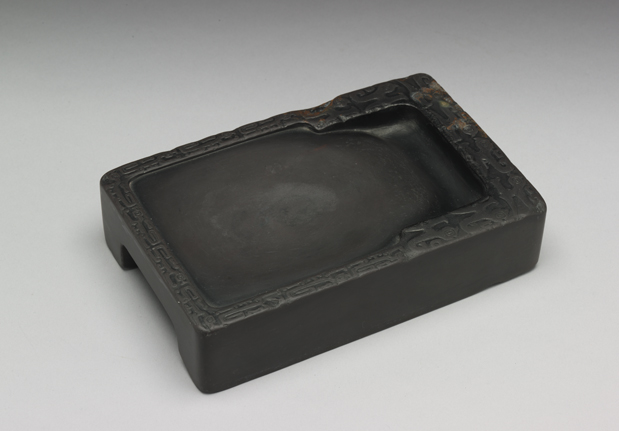Duan inkstone with archaic taotie-beast and kui-dragon pattern, Ming dynasty (1368-1644)
- Image Number: K1F001651N000000000PAB
- Dynasty: Ming dynasty
- Category: Studio implements
- Function: Stationery and stationery
- Material: Minerals/Jade Jewelry/Endstone
- Description:
Duanshi, “Western Qing Inkstone Manual” says: “The banana leaves in the old water pit are white”, and the stone is very delicate. The inkstone is made in the rectangular hand copying style, with two broad pitches. The surface of the inkstone is carved into a bottle shape. The ink pool is from the bottle mouth to the shoulder, and the inkstone hall is almost wide. Near the top left of the ink pool, there is a stone eye with eel blood spots. Around the ink pool, eight gluttonous patterns are carved. Around the inkstone, ten Kui patterns are carved. The back of the inkstone is from top to bottom. The two pitches hold the tars 1.9 cm high, Inkstone head wall is engraved with an inscription by Emperor Gaozong of the Qing Dynasty: “To make gluttony in the ancient times of the bottle Lei, abstain from eating and drink and use gluttonous fillings to symbolize compliance with the square. Who uses it to carve inkstone, whose meaning can be seen in detail. Every thief can show off himself, and the harm of literature can also be seen. I will use it as a warning. It has a long taste and can never be forgotten after reading Changli’s works.” Title: “Imperial Inscription of the Emperor Qianlong in 1898”, with the seal of “Ancient Fragrance” and “Tai Pu”. According to this inkstone, it was recorded in Complete Works of Imperial Poems and Prose of Emperor Gaozong of the Qing Dynasty (1) and Complete Works of Imperial Prose (2), volume 39, page 11. “Wuxu” was in 1778, the 43rd year of Qianlong, Emperor Gaozong of the Qing Dynasty.

![图片[2]-Duan inkstone with archaic taotie-beast and kui-dragon pattern, Ming dynasty (1368-1644)-China Archive](https://chinaarchive.net/Ming dynasty/Studio implements/K1F001651N000000000PAB-53673.jpg)
![图片[3]-Duan inkstone with archaic taotie-beast and kui-dragon pattern, Ming dynasty (1368-1644)-China Archive](https://chinaarchive.net/Ming dynasty/Studio implements/K1F001651N000000000PAB-53674.jpg)
Pictures & Images [HD] download
© Copyright
The copyright of the article belongs to the author, please keep the original link for reprinting.
THE END





